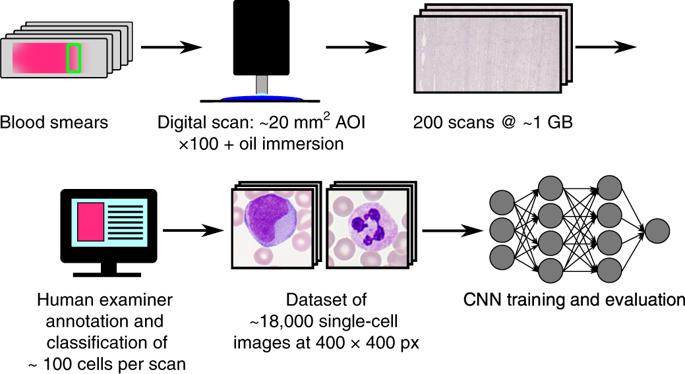The reliable diagnosis of myeloid leukaemia by identifying blast cells in peripheral blood is currently still a very complicated process. The identification is carried out entirely analogously, by well-trained technical staff and doctors. On the one hand, this is precisely why the error rate is very low; on the other hand, it is not possible to define standardised procedures that would be very helpful for routine processes. In addition, the purely analogue process is very time-consuming and monotonous and therefore very tiring.
What is the research about?
Dr Matek and other scientists have addressed the issue in the article “Human-level recognition of blast cells in acute myeloid leukaemia with convolutional neural networks” in the journal Nature Machine Intelligence (https://doi. org/10.1038/s42256-019-0101-9) addressed the issue of whether it was possible to run the identification process through a pre-trained algorithm and thus support the decision-making of specialists through artificial intelligence. Using our digital scanner O8 and an artificial neural network from the field of machine learning Convolutional Neural Network (CNN), several thousand individual images were first trained and then the reliability of the classification was tested via a so-called cross-validation.

Excerpt of the results
One of the results of the study that we want to mention because it also plays an important role for our product O8 is the so-called saliency map. This representation visualises how important certain pixels on an image were for the analysis. In figure 1 you can see that the areas where the cells are visible in the colour image were clearly more relevant for the analysis. Thus, we can say that on the one hand the network resulted in a very specific and good recognition of the cells, but also that the scanner was able to provide high-quality images for the recognition. In addition, the good networking of our software with further interfaces for the transfer of the scanner data into the basic CNN structure offered a safe and simple further processing of the images.
Here, we compile an annotated image dataset of over 18,000 white blood cells, use it to train a convolutional neural network for leukocyte classification and evaluate the network’s performance by comparing to inter- and intra-expert variability.
Matek, C., Schwarz, S., Spiekermann, K. et al. Human-level recognition of blast cells in acute myeloid leukaemia with convolutional neural networks. Nat Mach Intell 1, 538–544 (2019). https://doi.org/10.1038/s42256-019-0101-9 Tweet
In general, excellent results were achieved in this study, which provide a good foundation for further research into diagnosis with artificial intelligence. We are pleased and proud of what our product could contribute to this study. If you are interested in the topic and would like to learn more about the work.
Quellen:
Abbildung 1: Matek, Christian / Simone Schwarz / Karsten Spiekermann / Carsten Marr (2019): Human-level recognition of blast cells in acute myeloid leukaemia with convolutional neural networks, in: Nature Machine Intelligence, Jg. 1, Nr. 11, S. 538–544, doi: 10.1038/s42256-019-0101-9.









